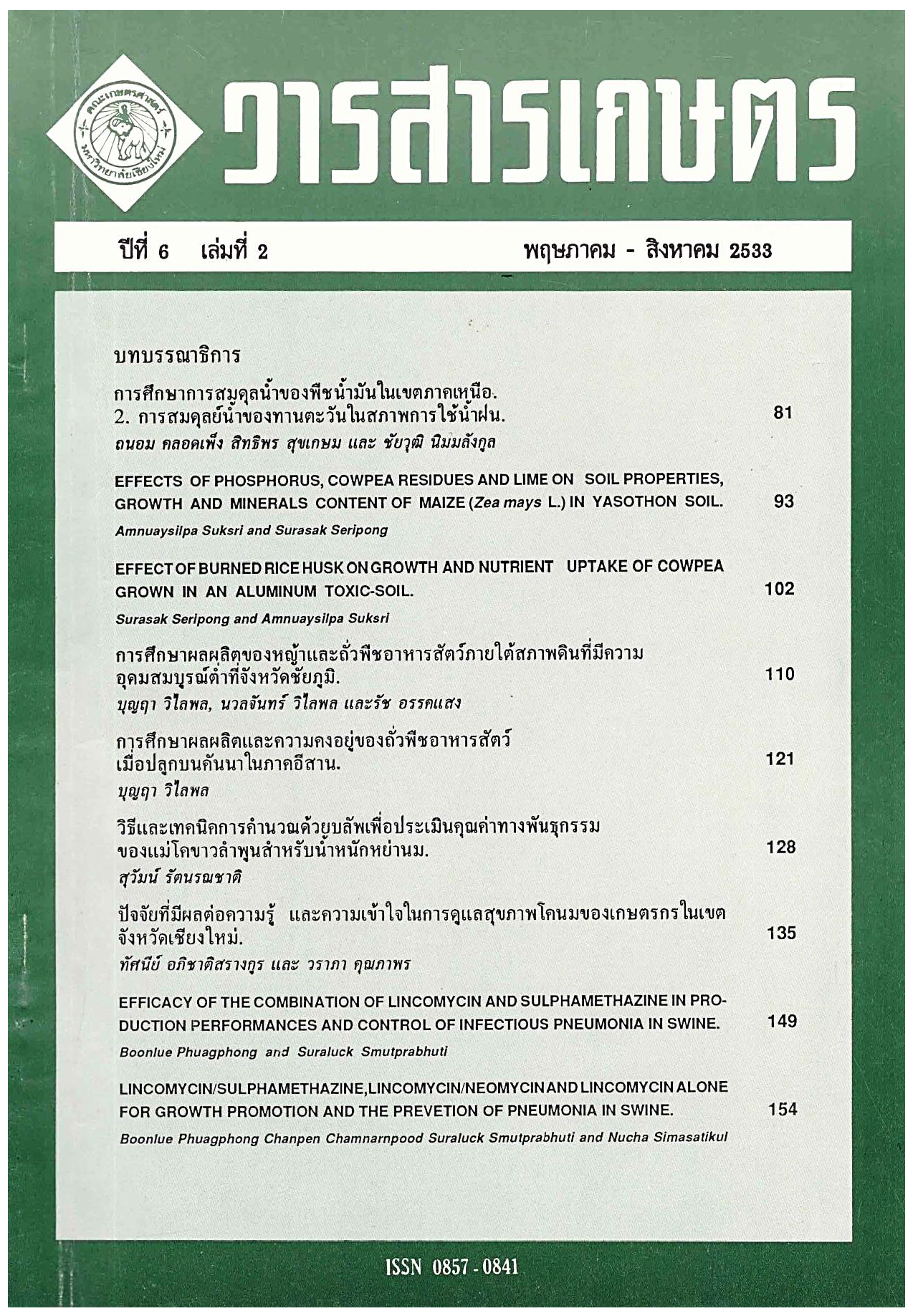LINCOMYCIN / SULPHAMETHAZINE, LINCOMYCIN / NEOMYCIN AND LINCOMYCIN ALONE FOR GROWTH PROMOTION AND THE PREVENTION OF PNEUMONIA IN SWINE
Main Article Content
บทคัดย่อ
Thirty Large White x Landrace barrows and 30 similar bred gilts were used in a randomized complete block design experiment determining the efficacy of Lincomycin/ Sulphamethazine, Lincomycin/Neomycin and Lincomycin alone at different levels and periods of time on swine growth promotion and prevention of pneumonia.
Six barrows and six gilts were assigned at random to one treatment with three replications. These swine were fed ad libitum with a 16.24% protein, for the first period, form the beginning (14.91 kg.liveweight) to 45th feeding day and continued feeding until 90th feeding day with a 13.38% protein as the second period. Swine rations were medicated with none (0-0), Lincomycin (220 ppm-0), Lincomycin (220 ppm-44 ppm), Lincomycin/Neomycin Lincomycin (44/100 ppm-22 ppm) and Lincomycin/Sulphamethazine (44/110 ppm 22/55 ppm) for the first and second period as treatments I, II, III, IV and V, respectively.
After 90th feeding day, 6 swine (3 males and 3 females) from each treatment were randomly slaughtered to determine the lesions of lungs through both gross lesions and microorganism culture caused by pathogenic bacteria and mycoplasma.
Significant differences were obtained in all aspects of production criteria used in this study for the first and second period of growth, except feed conversion ratio from the beginning to 45th feeding day. However, significant differences were not found in the same criteria from 45th to 90th feeding day.
The infectious pneumonia caused by pathogenic bacteria and/or mycoplasma were not found in all treatments of this study. Mortality and morbidity and other defects were not observed in any experimental swine.
It is obvious from this study that, for better productivity and control of respiratory diseases, medicated swine rations should be practiced.
Article Details
เอกสารอ้างอิง
Boonlue Phuagphong, Theera Visitpanich and Suraluck Smutprabhuti. (1984). Efficacy of none feed additive in production performances and control of infectious pneumonia in swine. Final Report to Upjohn Company (Thailand).
Braude, R., Kon, s.k. and Porter, J.W.G. (1953), Antibiotics in nutrition. Nutr. Abstr. & Rev. 23 (1): 473- 495.
Eusebio, J.A. and Puyaoan, R.B. (1958). The effect of T.M. 5 (Terramycin feed supple ment) upon rate of growth of growing and fattening pigs. The Philippine Agri culturist. 41: 499-504.
Gonzales, R.R., Supnet, M.G.. Puyaoan, R.B. and Rigor, E.M. (1962). The differnt levels of protein with and without terramycin growth rate and feed efficiency ofgrowing fattening pigs. The Philippine Ag riculturist. 46(7): 525-538.
Gropp, J. and Schulz, V. (1975). Feed antibiotics in fattening pigs. Nutr. Abstr. & Rev. 45(2): 164. Moser B.D. (1977). Weaned pigs. Simple diet may be adequate. Nutr. Abstr. & Rev. Series. B. 47 (3): 193


